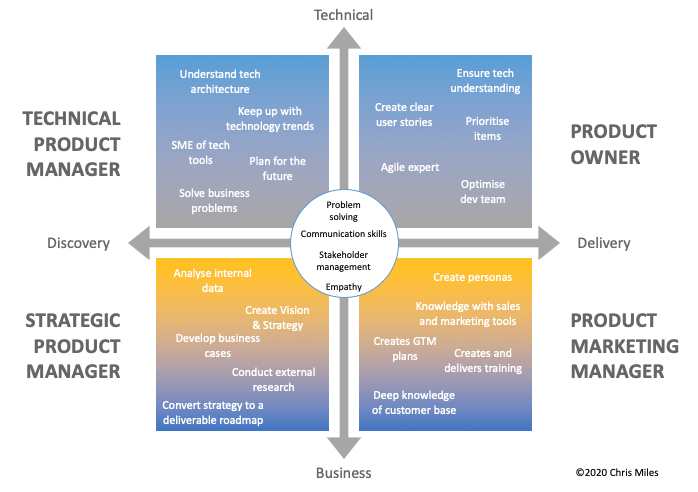Most of us have a hard enough time living in the here and now and doing our day jobs, let alone thinking about the future.
It’s understandable that most of us don’t make time for personal development. Who wants to spend time after a hard day of work learning and developing when they could be kicking back with a beer and watching The Crown?
It’s a lot about how you frame it. If you think about what you want, and where you want to be, the intrinsic and extrinsic value of your development increases massively.
This post is about just that — determining what kind of product manager you are, what kind you want to be and creating a development plan based on it.
A few months ago, I introduced a concept I have developed called the PM Quadrants. I’ve talked about what types of product manager there are, what each type is responsible for and also what elements of other roles often creep into the responsibilities of a product manager.
This post brings these all together to provide you with a four-step process to create your own Career Development Plan.
Quick Recap
Here’s a reminder of the four quadrants and their definitions.

And an overview of the key responsibilities of each quadrant:

Alright, that’s a brief recap done, now let’s look at how you can use these quadrants to help your career.
Applying the quadrants to develop your career
Here’s how to use these quadrants to determine where you currently sit, where you want to be and how to get there.
Step 1: Determine your product fit
This step is to determine which elements of your role should form the focus of your development plan, and which you should try and phase out.
Here’s how to do it:
- Write down the key tasks and responsibilities of your current role
- Compare them to the product quadrant graph below
- Make note of how much of your role is in (the blue and blue & yellow quadrants) and out (the orange area) of the ‘PM Zone’
- Move on to step 2

Step 2: Determine your top quadrants
Determining your primary and secondary quadrants will allow you to benchmark your skills, establish your interests and filter job opportunities.
2a: Determining based on your current role and skills
- Take the requirements of your role that you jotted down in step 1.
- Review your list against the quadrants to determine the quadrant that fits you best, and the second-best fit too.
- Do the same again but thinking about your overall skill set, not just your current responsibilities.
In reality, you’ll likely have a feel for your top quadrants anecdotally, but reviewing the list will help confirm or deny your feeling.
I’ll use myself as an example. Based on my most recent role as a Product Lead, my primary quadrant is the Strategic Product Manager, because the main responsibilities of my role were to conduct research, determine the vision and strategy, set up a product function and create, and support, a realistic roadmap.
If I want to sit purely in this box, then working in a start-up is out of the question as there simply isn’t room in the budget for such a specialised role. Consulting and large companies with at least some agile and digital competency are where this quadrant can thrive.
Based on the same role, my secondary quadrant is the Product Owner. It was important that I ‘got my hands dirty’ through backlog prioritisation, ticket creation and collaboration with the development team.
When looking at my skillset, the answer for me is the same, as I took the job based on the alignment with my skills and interests.
I have a strong understanding of agile principles and values and have worked in Scrum, Kanban and SAFe as a Product Owner. This box is the bread and butter of the product management industry and, coupled with my primary quadrant, makes me more appealing in smaller organisations.
2b: Determining where you want to be
You’ve mapped which quadrants most align to your current role and skills, but what about where you want to work in the future?
I’m not talking about seniority just yet — I’ll cover that in a minute.
Review the quadrants again and think about which direction you want your career to develop. Do you want to drill-down on one area (Suitable for larger organisations) or foray into multiple (more suited to start-ups)?
Do you want to become an expert Product Owner, evangelising all things agile and delivering great products, or would you enjoy product discovery and setting the strategy more?
For instance, you cannot take a product to market without the requisite Product Marketing Manager knowledge, and in fact, this is an area I personally want to develop further.
So while I have determined my primary and secondary quadrant, I am mindful that I want to develop further in the Product Marketing Manager quadrant. I’m going to call this my ‘development’ quadrant.

Step 3: Determine your development needs
I’ve broken this step down into three parts, to ascertain your strengths, gaps and future considerations.
3a: Focus on your strengths
I was introduced to the Gallup CliftonStrengths model back in 2012, which focusses on identifying and building on your strengths rather than your weaknesses.
This helped me realise that I wanted to work in a role that utilised my soft skills — communication, stakeholder management, relationship building and working with others, above a more technical, or solo, domain.
As my career progressed, I also found that I had an aptitude for, and interest in, the ‘bigger picture’. My strategic acumen far exceeds my technical knowledge, but rather than learn various coding languages, I spend more of my development time reading strategy books like Drive, Good Strategy/ Bad Strategy, The Lean Startup and Start With Why.
If that doesn’t quite make sense, think about it this way. Cristiano Ronaldo works relentlessly to be the best footballer that he can be. He’s excellent in the air, he’s fast, and his finishing is second-to-none. But does he spend his training time practising improving his defensive positioning or tackling? No, he does not. He continues to build on his strengths because that’s how he can be most effective. There are other players responsible for defending.
By developing my strengths, I can set myself apart from others as an outstanding product manager in the Strategy and Product Owner quadrants.

Being a jack of all trades may seem great, but mastering one or a few areas of skills is more useful in a cross-functional team setting.
Ultimately it all boils down to the ‘the whole is more than the sum of its parts’ analogy (which, by the way, Aristotle never said).
Step 3b: Determine areas for development
As with most jobs, there are parts of my job that I love and parts of my job that are a necessity to allow me to do the bits that I love. My development plan accounts for both of these, and yours should too.
Only you can say what type of product manager you want to be, but using the information from the first two steps you should ask yourself the following questions.

Step 3c: Consider the future, not just the present
The biggest challenge that I see consistently is that many companies have a setup in which more junior roles are delivery focussed and then senior roles are strategically focussed.
Much like when we become people managers, it requires a different set of skills and can be very difficult to adapt to. Bear this in mind when considering your career plan and your current role.
Don’t just develop skills for your current role, develop skills that you will need in the future.
Senior product roles are likely to have more strategic, commercial and management requirements so make sure to factor this in to your development.
In summary — think ahead. If you know where you want to be, research what skills you need to get there. If not, review what your career path options may be and build skills that will help you with whichever route you choose.
Step 4: Create your career development plan
Now that you have assessed your role, your skills and considered your future in product, it’s time to create your Career Development Plan.
I don’t want this to become another thing that causes you to stress, or makes you feel bad when you miss an arbitrary deadline. It’s intended to be a helpful tool for you. A carrot, not a stick.
It also does not need to be in a pretty format. After all, it’s just for you.
Open a note, google doc or word doc and add the following titles:
Goal
Where do you want to be in 5 years’ from now? It’s that horrible, textbook question that is probably in the ‘Interviewing for dummies’ guide. But in this context, it’s useful because it will help you frame your development goals.
If I don’t know whether I want to be a pilot or a product manager in five years’ time, it’s hard to know what skills to develop. If my choices are at least somewhat narrow (e.g. product marketing manager or product owner) then I can at least focus on skills that are useful for both, like learning how to review data.
By asking myself this question, I realised I had become obsessed with ‘levels’. All my goals were around going up a rung on the corporate ladder, and not about developing skills to have the best, and most enjoyable, career.
Try to avoid aspiring to a specific title, and focus on the type of role you want to be doing. Change ‘I want to be a Head of Product in 5 years’ to ‘I want to be a respected expert (both internally and externally) in the field of product management, that is managing a team’.
Enablers
Get yourself a mentor (or two)
Having access to someone with a heap of experience to lean on for advice, introduce you to others in the community and help with access to great content and research will help your career development.
Ideally, I recommend having two mentors that fulfil different niches.
Mentor 1 — The older sibling: The Someone that isn’t too far ‘ahead’ of you in their career (say 2 years more experience), as the challenges and tribulations they faced will still be fresh in their mind.
Mentor 2 — The parent: A thought leader. Someone that you look up to professionally, and can help you understand the foundations you will need to put in place to get to the heady-heights of leadership.

Get yourself a coach
A mentor is not a coach and vice-versa. A coach does not need any expertise in your field (in fact, it’s often better if they have none). Simplifying it significantly, they will ask you probing questions to get you to use your brain and work out the right answer for you. All coaches are not made equal — I’ve had a few and they ranged from abrasive and transactional to welcoming and thoughtful.
List the skills you want to develop
Formalise the development needs you identified in step 3 into categories.
For instance, I have four categories in my development plan:
- Product Management skills and knowledge
- Digital Delivery
- Management
- Leadership
At the time of writing, these four categories reflected my role, my interests, skills and areas I knew I needed to develop to become a product leader.

I hope you found this useful and I’d love to hear your thoughts, questions and challenges!
261 Replies to “How to Develop Your Product Career, Using the Product Quadrants”